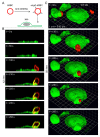Time-lapse 3D Imaging of Phagocytosis by Mouse Macrophages
- PMID: 30394377
- PMCID: PMC6235568
- DOI: 10.3791/57566
Time-lapse 3D Imaging of Phagocytosis by Mouse Macrophages
Abstract
Phagocytosis plays a key role in host defense, as well as in tissue development and maintenance, and involves rapid, receptor-mediated rearrangements of the actin cytoskeleton to capture, envelop and engulf large particles. Although phagocytic receptors, downstream signaling pathways, and effectors, such as Rho GTPases, have been identified, the dynamic cytoskeletal remodeling of specific receptor-mediated phagocytic events remain unclear. Four decades ago, two distinct mechanisms of phagocytosis, exemplified by Fcγ receptor (FcγR)- and complement receptor (CR)-mediated phagocytosis, were identified using scanning electron microscopy. Binding of immunoglobulin G (IgG)-opsonized particles to FcγRs triggers the protrusion of thin membrane extensions, which initially form a so-called phagocytic cup around the particle before it becomes completely enclosed and retracted into the cell. In contrast, complement opsonized particles appear to sink into the phagocyte following binding to complement receptors. These two modes of phagocytosis, phagocytic cup formation and sinking in, have become well established in the literature. However, the distinctions between the two modes have become blurred by reports that complement receptor-mediated phagocytosis may induce various membrane protrusions. With the availability of high resolution imaging techniques, phagocytosis assays are required that allow real-time 3D (three dimensional) visualization of how specific phagocytic receptors mediate the uptake of individual particles. More commonly used approaches for the study of phagocytosis, such as end-point assays, miss the opportunity to understand what is happening at the interface of particles and phagocytes. Here we describe phagocytic assays, using time-lapse spinning disk confocal microscopy, that allow 3D imaging of single phagocytic events. In addition, we describe assays to unambiguously image Fcγ receptor- or complement receptor-mediated phagocytosis.
Similar articles
-
Complement receptor 3 mediates both sinking phagocytosis and phagocytic cup formation via distinct mechanisms.J Biol Chem. 2021 Jan-Jun;296:100256. doi: 10.1016/j.jbc.2021.100256. Epub 2021 Jan 8. J Biol Chem. 2021. PMID: 33839682 Free PMC article.
-
Complement receptor 3 mediates both sinking phagocytosis and phagocytic cup formation via distinct mechanisms.J Biol Chem. 2021 Jan 4:jbc.RA120.015346. doi: 10.1074/jbc.RA120.015346. Online ahead of print. J Biol Chem. 2021. PMID: 33397789
-
CR3 ruffles FcγR's claim over phagocytic cups.J Biol Chem. 2021 Jan-Jun;296:100801. doi: 10.1016/j.jbc.2021.100801. Epub 2021 May 19. J Biol Chem. 2021. PMID: 34019878 Free PMC article.
-
Phagocytosis--the mighty weapon of the silent warriors.Microsc Res Tech. 2002 Jun 15;57(6):421-31. doi: 10.1002/jemt.10096. Microsc Res Tech. 2002. PMID: 12112425 Review.
-
Bacterial inhibition of phagocytosis.Cell Microbiol. 2000 Oct;2(5):379-86. doi: 10.1046/j.1462-5822.2000.00075.x. Cell Microbiol. 2000. PMID: 11207593 Review.
Cited by
-
Complement receptor 3 mediates both sinking phagocytosis and phagocytic cup formation via distinct mechanisms.J Biol Chem. 2021 Jan-Jun;296:100256. doi: 10.1016/j.jbc.2021.100256. Epub 2021 Jan 8. J Biol Chem. 2021. PMID: 33839682 Free PMC article.
-
Knockout mouse models reveal the contributions of G protein subunits to complement C5a receptor-mediated chemotaxis.J Biol Chem. 2020 May 29;295(22):7726-7742. doi: 10.1074/jbc.RA119.011984. Epub 2020 Apr 24. J Biol Chem. 2020. PMID: 32332099 Free PMC article.
References
-
- Tauber AI. Metchnikoff and the phagocytosis theory. Nature reviews. Molecular cell biology. 2003;4:897–901. - PubMed
-
- Kaplan G. Differences in the mode of phagocytosis with Fc and C3 receptors in macrophages. Scandinavian journal of immunology. 1977;6:797–807. - PubMed
-
- Caron E, Hall A. Identification of two distinct mechanisms of phagocytosis controlled by different Rho GTPases. Science. 1998;282:1717–1721. - PubMed
-
- Aderem A, Underhill DM. Mechanisms of phagocytosis in macrophages. Annual review of immunology. 1999;17:593–623. - PubMed
Publication types
MeSH terms
LinkOut - more resources
Full Text Sources
Other Literature Sources




